提示:
阅读本文需要一定的3D图形学和DirectX9基础,如果你发现阅读困难,请参阅
D3D中基本三角形面的绘制。本文用到的坐标系统变换函数请参阅
DirectX 9的坐标系统变换。
纹理是指物体表面本身所具有的图案,可采用贴图的方法将一张二维图象张贴到一个三维物体的表面,这就是所谓的纹理贴图技术。与材质一样,纹理也是物体表面的一种属性,同时结合材质,光照和纹理技术可对三维场景进行渲染,使渲染出来的三维图形更为逼真。
如下所示,使用纹理映射,就能在单色的多边形表面上使用图片进行着色:
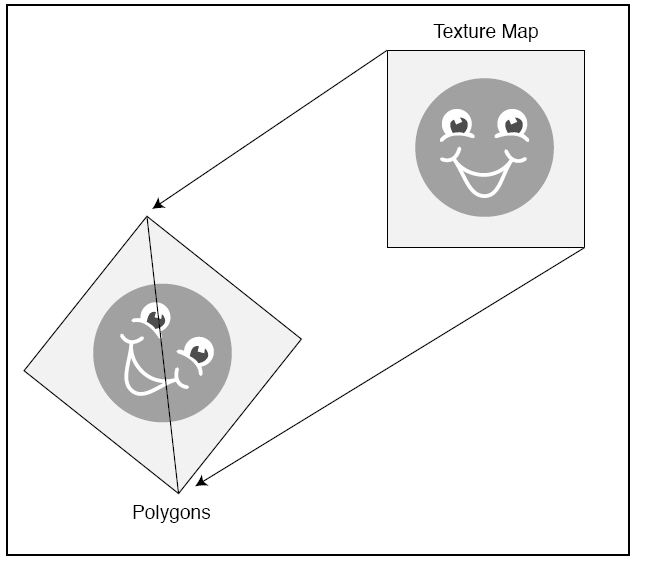 顶点的纹理坐标
顶点的纹理坐标纹理贴图也是利用三维物体的剖分三角形面来进行的,当每个三角形面贴图处理完毕,整个三维物体表面就可呈现出整体纹理效果。为此,需要为剖分三角形面的顶点添加相应的纹理坐标,以确定每个三角形面应贴上的图形区域。纹理图象也是由一个个像素点组成,为顶点选定纹理坐标,实际就是把纹理图象的像素点颜色值赋予相应的顶点。这样,三角形的内部像素点的颜色值就可以根据顶点的颜色值进行插值计算。顶点的纹理坐标必须与顶点坐标一起提供给渲染管道流水线。
如下所示,不管图像的大小是多少,纹理图像的u坐标和v坐标都是常数。
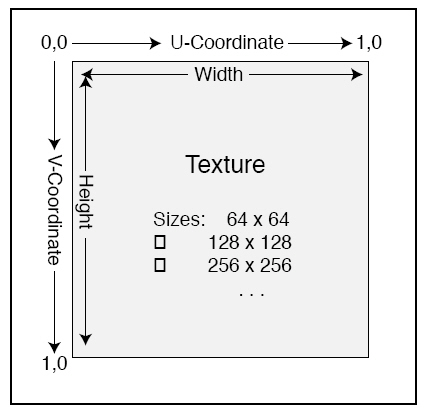 创建纹理对象
创建纹理对象当顶点的纹理坐标随着整个顶点结构体的数据倒入渲染管道流水线后,就必须将作为纹理的源图象数据设置给渲染管道流水线。为此,需要利用D3DXCreateTextureFromFile函数创建一个纹理对象,然后将该对象设置到渲染管道流水线。
Creates a texture from a file.
HRESULT D3DXCreateTextureFromFile(
LPDIRECT3DDEVICE9 pDevice,
LPCTSTR pSrcFile,
LPDIRECT3DTEXTURE9 * ppTexture
);
Parameters
- pDevice
- [in] Pointer to an IDirect3DDevice9 interface, representing the device to be associated with the texture.
- pSrcFile
- [in] Pointer to a string that specifies the filename. If the compiler settings require Unicode, the data type LPCTSTR resolves to LPCWSTR. Otherwise, the string data type resolves to LPCSTR. See Remarks.
- ppTexture
- [out] Address of a pointer to an IDirect3DTexture9 interface, representing the created texture object.
Return Values
If the function succeeds, the return value is D3D_OK. If the function fails, the return value can be one of the following:
D3DERR_NOTAVAILABLED3DERR_OUTOFVIDEOMEMORYD3DERR_INVALIDCALLD3DXERR_INVALIDDATAE_OUTOFMEMORY
Remarks
The compiler setting also determines the function version. If Unicode is defined, the function call resolves to D3DXCreateTextureFromFileW. Otherwise, the function call resolves to D3DXCreateTextureFromFileA because ANSI strings are being used.
This function supports the following file formats: .bmp, .dds, .dib, .hdr, .jpg, .pfm, .png, .ppm, and .tga. See D3DXIMAGE_FILEFORMAT.
The function is equivalent to D3DXCreateTextureFromFileEx(pDevice, pSrcFile, D3DX_DEFAULT, D3DX_DEFAULT, D3DX_DEFAULT, 0, D3DFMT_UNKNOWN, D3DPOOL_MANAGED, D3DX_DEFAULT, D3DX_DEFAULT, 0, NULL, NULL, ppTexture).
Mipmapped textures automatically have each level filled with the loaded texture.
When loading images into mipmapped textures, some devices are unable to go to a 1x1 image and this function will fail. If this happens, the images need to be loaded manually.
Note that a resource created with this function will be placed in the memory class denoted by D3DPOOL_MANAGED.
Filtering is automatically applied to a texture created using this method. The filtering is equivalent to D3DX_FILTER_TRIANGLE | D3DX_FILTER_DITHER in D3DX_FILTER.
For the best performance when using D3DXCreateTextureFromFile:
- Doing image scaling and format conversion at load time can be slow. Store images in the format and resolution they will be used. If the target hardware requires power of two dimensions, create and store images using power of two dimensions.
- Consider using DirectDraw surface (DDS) files. Because DDS files can be used to represent any Direct3D 9 texture format, they are very easy for D3DX to read. Also, they can store mipmaps, so any mipmap-generation algorithms can be used to author the images.
可以使用更高级的函数D3DXCreateTextureFromFileEx来创建纹理对象。
Creates a texture from a file. This is a more advanced function than D3DXCreateTextureFromFile.
HRESULT D3DXCreateTextureFromFileEx(
LPDIRECT3DDEVICE9 pDevice,
LPCTSTR pSrcFile,
UINT Width,
UINT Height,
UINT MipLevels,
DWORD Usage,
D3DFORMAT Format,
D3DPOOL Pool,
DWORD Filter,
DWORD MipFilter,
D3DCOLOR ColorKey,
D3DXIMAGE_INFO * pSrcInfo,
PALETTEENTRY * pPalette,
LPDIRECT3DTEXTURE9 * ppTexture
);
Parameters
- pDevice
- [in] Pointer to an IDirect3DDevice9 interface, representing the device to be associated with the texture.
- pSrcFile
- [in] Pointer to a string that specifies the filename. If the compiler settings require Unicode, the data type LPCTSTR resolves to LPCWSTR. Otherwise, the string data type resolves to LPCSTR. See Remarks.
- Width
- [in] Width in pixels. If this value is zero or D3DX_DEFAULT, the dimensions are taken from the file and rounded up to a power of two. If the device supports non-power of 2 textures and D3DX_DEFAULT_NONPOW2 is specified, the size will not be rounded.
- Height
- [in] Height, in pixels. If this value is zero or D3DX_DEFAULT, the dimensions are taken from the file and rounded up to a power of two. If the device supports non-power of 2 textures and D3DX_DEFAULT_NONPOW2 is sepcified, the size will not be rounded.
- MipLevels
- [in] Number of mip levels requested. If this value is zero or D3DX_DEFAULT, a complete mipmap chain is created. If D3DX_FROM_FILE, the size will be taken exactly as it is in the file, and the call will fail if this violates device capabilities.
- Usage
- [in] 0, D3DUSAGE_RENDERTARGET, or D3DUSAGE_DYNAMIC. Setting this flag to D3DUSAGE_RENDERTARGET indicates that the surface is to be used as a render target. The resource can then be passed to the pNewRenderTarget parameter of the IDirect3DDevice9::SetRenderTarget method. If either D3DUSAGE_RENDERTARGET or D3DUSAGE_DYNAMIC is specified, Pool must be set to D3DPOOL_DEFAULT, and the application should check that the device supports this operation by calling IDirect3D9::CheckDeviceFormat. D3DUSAGE_DYNAMIC indicates that the surface should be handled dynamically. See Using Dynamic Textures.
- Format
- [in] Member of the D3DFORMAT enumerated type, describing the requested pixel format for the texture. The returned texture might have a different format from that specified by Format. Applications should check the format of the returned texture. If D3DFMT_UNKNOWN, the format is taken from the file. If D3DFMT_FROM_FILE, the format is taken exactly as it is in the file, and the call will fail if this violates device capabilities.
- Pool
- [in] Member of the D3DPOOL enumerated type, describing the memory class into which the texture should be placed.
- Filter
- [in] A combination of one or more D3DX_FILTER constants controlling how the image is filtered. Specifying D3DX_DEFAULT for this parameter is the equivalent of specifying D3DX_FILTER_TRIANGLE | D3DX_FILTER_DITHER.
- MipFilter
- [in] A combination of one or more D3DX_FILTER constants controlling how the image is filtered. Specifying D3DX_DEFAULT for this parameter is the equivalent of specifying D3DX_FILTER_BOX. In addition, use bits 27-31 to specify the number of mip levels to be skipped (from the top of the mipmap chain) when a .dds texture is loaded into memory; this allows you to skip up to 32 levels.
- ColorKey
- [in] D3DCOLOR value to replace with transparent black, or 0 to disable the color key. This is always a 32-bit ARGB color, independent of the source image format. Alpha is significant and should usually be set to FF for opaque color keys. Thus, for opaque black, the value would be equal to 0xFF000000.
- pSrcInfo
- [in, out] Pointer to a D3DXIMAGE_INFO structure to be filled in with a description of the data in the source image file, or NULL.
- pPalette
- [out] Pointer to a PALETTEENTRY structure, representing a 256-color palette to fill in, or NULL.
- ppTexture
- [out] Address of a pointer to an IDirect3DTexture9 interface, representing the created texture object.
Return Values
If the function succeeds, the return value is D3D_OK. If the function fails, the return value can be one of the following: D3DERR_INVALIDCALL.
D3DERR_NOTAVAILABLED3DERR_OUTOFVIDEOMEMORYD3DXERR_INVALIDDATAE_OUTOFMEMORY
Remarks
The compiler setting also determines the function version. If Unicode is defined, the function call resolves to D3DXCreateTextureFromFileExW. Otherwise, the function call resolves to D3DXCreateTextureFromFileExA because ANSI strings are being used.
Use D3DXCheckTextureRequirements to determine if your device can support the texture given the current state.
This function supports the following file formats: .bmp, .dds, .dib, .hdr, .jpg, .pfm, .png, .ppm, and .tga. See D3DXIMAGE_FILEFORMAT.
Mipmapped textures automatically have each level filled with the loaded texture. When loading images into mipmapped textures, some devices are unable to go to a 1x1 image and this function will fail. If this happens, then the images need to be loaded manually.
For the best performance when using D3DXCreateTextureFromFileEx:
- Doing image scaling and format conversion at load time can be slow. Store images in the format and resolution they will be used. If the target hardware requires power of 2 dimensions, then create and store images using power of 2 dimensions.
- For mipmap image creation at load time, filter using D3DX_FILTER_BOX. A box filter is much faster than other filter types such as D3DX_FILTER_TRIANGLE.
- Consider using DDS files. Since DDS files can be used to represent any Direct3D 9 texture format, they are very easy for D3DX to read. Also, they can store mipmaps, so any mipmap-generation algorithms can be used to author the images.
When skipping mipmap levels while loading a .dds file, use the D3DX_SKIP_DDS_MIP_LEVELS macro to generate the MipFilter value. This macro takes the number of levels to skip and the filter type and returns the filter value, which would then be passed into the MipFilter parameter.
当然也可以通过IDirect3DDevice9::CreateTexture来创建一个纹理对象。
Creates a texture resource.
HRESULT CreateTexture(
UINT Width,
UINT Height,
UINT Levels,
DWORD Usage,
D3DFORMAT Format,
D3DPOOL Pool,
IDirect3DTexture9** ppTexture,
HANDLE* pSharedHandle
);
Parameters
- Width
- [in] Width of the top-level of the texture, in pixels. The pixel dimensions of subsequent levels will be the truncated value of half of the previous level's pixel dimension (independently). Each dimension clamps at a size of 1 pixel. Thus, if the division by 2 results in 0, 1 will be taken instead.
- Height
- [in] Height of the top-level of the texture, in pixels. The pixel dimensions of subsequent levels will be the truncated value of half of the previous level's pixel dimension (independently). Each dimension clamps at a size of 1 pixel. Thus, if the division by 2 results in 0, 1 will be taken instead.
- Levels
- [in] Number of levels in the texture. If this is zero, Direct3D will generate all texture sublevels down to 1 by 1 pixels for hardware that supports mipmapped textures. Call IDirect3DBaseTexture9::GetLevelCount to see the number of levels generated.
- Usage
- [in] Usage can be 0, which indicates no usage value. However, if usage is desired, use a combination of one or more D3DUSAGE constants. It is good practice to match the usage parameter with the behavior flags in IDirect3D9::CreateDevice.
- Format
- [in] Member of the D3DFORMAT enumerated type, describing the format of all levels in the texture.
- Pool
- [in] Member of the D3DPOOL enumerated type, describing the memory class into which the texture should be placed.
- ppTexture
- [out, retval] Pointer to an IDirect3DTexture9 interface, representing the created texture resource.
- pSharedHandle
- [in] Reserved. Set this parameter to NULL.
Return Values
If the method succeeds, the return value is D3D_OK. If the method fails, the return value can be one of the following: D3DERR_INVALIDCALL, D3DERR_OUTOFVIDEOMEMORY, E_OUTOFMEMORY.
Remarks
An application can discover support for Automatic Generation of Mipmaps (Direct3D 9) in a particular format by calling IDirect3D9::CheckDeviceFormat with D3DUSAGE_AUTOGENMIPMAP. If IDirect3D9::CheckDeviceFormat returns D3DOK_NOAUTOGEN, IDirect3DDevice9::CreateTexture will succeed but it will return a one-level texture.
通过IDirect3DTexture9::LockRect创建完IDirect3DTexture9对象后,可以通过IDirect3DTexture9::LockRect获得纹理数据。
Locks a rectangle on a texture resource.
HRESULT LockRect(
UINT Level,
D3DLOCKED_RECT * pLockedRect,
CONST RECT * pRect,
DWORD Flags
);
Parameters
- Level
- [in] Specifies the level of the texture resource to lock.
- pLockedRect
- [out] Pointer to a D3DLOCKED_RECT structure, describing the locked region.
- pRect
- [in] Pointer to a rectangle to lock. Specified by a pointer to a RECT structure. Specifying NULL for this parameter expands the dirty region to cover the entire texture.
- Flags
- [in] Combination of zero or more locking flags that describe the type of lock to perform. For this method, the valid flags are:
- D3DLOCK_DISCARD
- D3DLOCK_NO_DIRTY_UPDATE
- D3DLOCK_NOSYSLOCK
- D3DLOCK_READONLY
You may not specify a subrect when using D3DLOCK_DISCARD. For a description of the flags, see D3DLOCK.
Return Values
If the method succeeds, the return value is D3D_OK. If the method fails, the return value can be D3DERR_INVALIDCALL.
Remarks
Textures created with D3DPOOL_DEFAULT are not lockable. Textures created in video memory are lockable when created with USAGE_DYNAMIC.
For performance reasons, dirty regions are recorded only for level zero of a texture. Dirty regions are automatically recorded when IDirect3DTexture9::LockRect is called without D3DLOCK_NO_DIRTY_UPDATE or D3DLOCK_READONLY. See IDirect3DDevice9::UpdateTexture for more information.
The only lockable format for a depth-stencil texture is D3DLOCK_D16_LOCKABLE.
Video memory textures cannot be locked, but must be modified by calling IDirect3DDevice9::UpdateSurface or IDirect3DDevice9::UpdateTexture. There are exceptions for some proprietary driver pixel formats that Direct3D 9 does not recognize. These can be locked.
This method cannot retrieve data from a texture resource created with D3DUSAGE_RENDERTARGET because such a texture must be assigned to D3DPOOL_DEFAULT memory and is therefore not lockable. In this case, use instead IDirect3DDevice9::GetRenderTargetData to copy texture data from device memory to system memory.
锁定之后,必须通过IDirect3DTexture9::UnlockRect来对IDirect3DTexture9对象进行解锁。
Unlocks a rectangle on a texture resource.
HRESULT UnlockRect(
UINT Level
);
Parameters
- Level
- [in] Specifies the level of the texture resource to unlock.
Return Values
If the method succeeds, the return value is D3D_OK. If the method fails, the return value can be D3DERR_INVALIDCALL.
利用IDirect3DDevice9接口提供的SetTexture函数进行纹理设置,由于可进行多次纹理蒙皮,将纹理对象设置给固定渲染管道流水线时,必须提供所在的采样器序号或纹理状态序号,以区别不同的纹理处理。
Sets a texture.
HRESULT SetTexture(
D3DXHANDLE hParameter,
LPDIRECT3DBASETEXTURE9 pTexture
);
Parameters
- hParameter
- [in] Unique identifier. See Handles.
- pTexture
- [in] Texture object. See IDirect3DBaseTexture9.
Return Values
If the method succeeds, the return value is D3D_OK. If the method fails, the return value can be D3DERR_INVALIDCALL.
可以通过GetLevelDesc来获取特定采样级别的纹理表面描述信息:
Retrieves a level description of a texture resource.
HRESULT GetLevelDesc(
UINT Level,
D3DSURFACE_DESC * pDesc
);
Parameters
- Level
- [in] Identifies a level of the texture resource. This method returns a surface description for the level specified by this parameter.
- pDesc
- [out] Pointer to a D3DSURFACE_DESC structure, describing the returned level.
Return Values
If the method succeeds, the return value is D3D_OK. D3DERR_INVALIDCALL is returned if one of the arguments is invalid.
pDesc为一个指向D3DSURFACE_DESC数据类型的指针,来看看它的具体定义:
Describes a surface.
typedef struct D3DSURFACE_DESC {
D3DFORMAT Format;
D3DRESOURCETYPE Type;
DWORD Usage;
D3DPOOL Pool;
D3DMULTISAMPLE_TYPE MultiSampleType;
DWORD MultiSampleQuality;
UINT Width;
UINT Height;
} D3DSURFACE_DESC, *LPD3DSURFACE_DESC;
Members
- Format
- Member of the D3DFORMAT enumerated type, describing the surface format.
- Type
- Member of the D3DRESOURCETYPE enumerated type, identifying this resource as a surface.
- Usage
- Either the D3DUSAGE_DEPTHSTENCIL or D3DUSAGE_RENDERTARGET values. For more information, see D3DUSAGE.
- Pool
- Member of the D3DPOOL enumerated type, specifying the class of memory allocated for this surface.
- MultiSampleType
- Member of the D3DMULTISAMPLE_TYPE enumerated type, specifying the levels of full-scene multisampling supported by the surface.
- MultiSampleQuality
- Quality level. The valid range is between zero and one less than the level returned by pQualityLevels used by IDirect3D9::CheckDeviceMultiSampleType. Passing a larger value returns the error, D3DERR_INVALIDCALL. The MultisampleQuality values of paired render targets, depth stencil surfaces and the MultiSample type must all match.
- Width
- Width of the surface, in pixels.
- Height
- Height of the surface, in pixels.
其中Type描述了资源的类型:
Defines resource types.
typedef enum D3DRESOURCETYPE
{
D3DRTYPE_SURFACE = 1,
D3DRTYPE_VOLUME = 2,
D3DRTYPE_TEXTURE = 3,
D3DRTYPE_VOLUMETEXTURE = 4,
D3DRTYPE_CubeTexture = 5,
D3DRTYPE_VERTEXBUFFER = 6,
D3DRTYPE_INDEXBUFFER = 7,
D3DRTYPE_FORCE_DWORD = 0x7fffffff,
} D3DRESOURCETYPE, *LPD3DRESOURCETYPE;
Constants
- D3DRTYPE_SURFACE
- Surface resource.
- D3DRTYPE_VOLUME
- Volume resource.
- D3DRTYPE_TEXTURE
- Texture resource.
- D3DRTYPE_VOLUMETEXTURE
- Volume texture resource.
- D3DRTYPE_CubeTexture
- Cube texture resource.
- D3DRTYPE_VERTEXBUFFER
- Vertex buffer resource.
- D3DRTYPE_INDEXBUFFER
- Index buffer resource.
- D3DRTYPE_FORCE_DWORD
- Forces this enumeration to compile to 32 bits in size. Without this value, some compilers would allow this enumeration to compile to a size other than 32 bits. This value is not used.
纹理过滤技术当三角形顶点对应的纹理像素点选定以后,具体如何确定三角形面的内部像素点的颜色值,就需要应用插值方法进行计算,即所谓的纹理过滤技术,包括Mipmap过滤技术,MagFilter过滤技术, MinFilter过滤技术等。
Mipmap技术是指利用同一幅纹理源图的不同大小,对远近不同的物体采用不同的表面纹理,即较远的物体采用尺寸大的纹理图象进行贴图,较近的物体采用尺寸小的纹理图象进行贴图,既可提高纹理贴图的速度,又不致于使三维物体的纹理渲染效果产生较大的失真。
由于二维贴图的三角形面的大小一般与纹理图象的大小不同,因此需要将纹理源图进行相应的放大或缩小,以确定渲染三角形面内部像素点的颜色值,这就是MagFilter过滤技术和MinFilter过滤技术。
当使用D3DXCreateTextureFromFile创建纹理对象时,该函数会自动根据纹理源图的大小,创建出一连串的逐级减少的纹理对象,这样当纹理图象贴上三维物体表面时,会自动根据渲染表面的大小,选择合适尺寸的纹理对象进行贴图,以减少三角形内部像素点颜色值的插值计算量。
注: 纹理图象的大小不一定是宽高相等的,例如纹理源图为256 x 128大小,那么它的各级Mipmap图象大小分别为128 x 64, 64 x 32, 32 x 16, 16 x 8, 8 x 4, 4 x 2和2 x 1。
渲染管道流水线所使用的过滤技术类型可通过IDirect3DDevice9设备接口提供的 SetSampleState函数来设定。
Sets the sampler state value.
HRESULT SetSamplerState(
DWORD Sampler,
D3DSAMPLERSTATETYPE Type,
DWORD Value
);
Parameters
- Sampler
- [in] The sampler stage index.
- Type
- [in] This parameter can be any member of the D3DSAMPLERSTATETYPE enumerated type.
- Value
- [in] State value to set. The meaning of this value is determined by the Type parameter.
Return Values
If the method succeeds, the return value is D3D_OK. If the method fails, the return value can be D3DERR_INVALIDCALL.
来看看D3DSAMPLERSTATETYPE的具体定义:
Sampler states define texture sampling operations such as texture addressing and texture filtering. Some sampler states set-up vertex processing, and some set-up pixel processing. Sampler states can be saved and restored using stateblocks (see State Blocks Save and Restore State (Direct3D 9)).
typedef enum D3DSAMPLERSTATETYPE
{
D3DSAMP_ADDRESSU = 1,
D3DSAMP_ADDRESSV = 2,
D3DSAMP_ADDRESSW = 3,
D3DSAMP_BORDERCOLOR = 4,
D3DSAMP_MAGFILTER = 5,
D3DSAMP_MINFILTER = 6,
D3DSAMP_MIPFILTER = 7,
D3DSAMP_MIPMAPLODBIAS = 8,
D3DSAMP_MAXMIPLEVEL = 9,
D3DSAMP_MAXANISOTROPY = 10,
D3DSAMP_SRGBTEXTURE = 11,
D3DSAMP_ELEMENTINDEX = 12,
D3DSAMP_DMAPOFFSET = 13,
D3DSAMP_FORCE_DWORD = 0x7fffffff,
} D3DSAMPLERSTATETYPE, *LPD3DSAMPLERSTATETYPE;
Constants
- D3DSAMP_ADDRESSU
- Texture-address mode for the u coordinate. The default is D3DTADDRESS_WRAP. For more information, see D3DTEXTUREADDRESS.
- D3DSAMP_ADDRESSV
- Texture-address mode for the v coordinate. The default is D3DTADDRESS_WRAP. For more information, see D3DTEXTUREADDRESS.
- D3DSAMP_ADDRESSW
- Texture-address mode for the w coordinate. The default is D3DTADDRESS_WRAP. For more information, see D3DTEXTUREADDRESS.
- D3DSAMP_BORDERCOLOR
- Border color or type D3DCOLOR. The default color is 0x00000000.
- D3DSAMP_MAGFILTER
- Magnification filter of type D3DTEXTUREFILTERTYPE. The default value is D3DTEXF_POINT.
- D3DSAMP_MINFILTER
- Minification filter of type D3DTEXTUREFILTERTYPE. The default value is D3DTEXF_POINT.
- D3DSAMP_MIPFILTER
- Mipmap filter to use during minification. See D3DTEXTUREFILTERTYPE. The default value is D3DTEXF_NONE.
- D3DSAMP_MIPMAPLODBIAS
- Mipmap level-of-detail bias. The default value is zero.
- D3DSAMP_MAXMIPLEVEL
- level-of-detail index of largest map to use. Values range from 0 to (n - 1) where 0 is the largest. The default value is zero.
- D3DSAMP_MAXANISOTROPY
- DWORD maximum anisotropy. The default value is 1.
- D3DSAMP_SRGBTEXTURE
- Gamma correction value. The default value is 0, which means gamma is 1.0 and no correction is required. Otherwise, this value means that the sampler should assume gamma of 2.2 on the content and convert it to linear (gamma 1.0) before presenting it to the pixel shader.
- D3DSAMP_ELEMENTINDEX
- When a multielement texture is assigned to the sampler, this indicates which element index to use. The default value is 0.
- D3DSAMP_DMAPOFFSET
- Vertex offset in the presampled displacement map. This is a constant used by the tessellator, its default value is 0.
- D3DSAMP_FORCE_DWORD
- Forces this enumeration to compile to 32 bits in size. Without this value, some compilers would allow this enumeration to compile to a size other than 32 bits. This value is not used.
对于过滤技术来说,Type参数可取值D3DSAMP_MIPFILTER,D3DSAMP_MAGFILTER和 D3DSAMP_MINFILTER,而Value参数可取如下类型的枚举值。
Defines texture filtering modes for a texture stage.
typedef enum D3DTEXTUREFILTERTYPE
{
D3DTEXF_NONE = 0,
D3DTEXF_POINT = 1,
D3DTEXF_LINEAR = 2,
D3DTEXF_ANISOTROPIC = 3,
D3DTEXF_PYRAMIDALQUAD = 6,
D3DTEXF_GAUSSIANQUAD = 7,
D3DTEXF_FORCE_DWORD = 0x7fffffff,
} D3DTEXTUREFILTERTYPE, *LPD3DTEXTUREFILTERTYPE;
Constants
- D3DTEXF_NONE
- Mipmapping disabled. The rasterizer should use the magnification filter instead.
- D3DTEXF_POINT
- Point filtering used as a texture magnification or minification filter. The texel with coordinates nearest to the desired pixel value is used. The texture filter to be used between mipmap levels is nearest-point mipmap filtering. The rasterizer uses the color from the texel of the nearest mipmap texture.
- D3DTEXF_LINEAR
- Bilinear interpolation filtering used as a texture magnification or minification filter. A weighted average of a 2 x 2 area of texels surrounding the desired pixel is used. The texture filter to use between mipmap levels is trilinear mipmap interpolation. The rasterizer linearly interpolates pixel color, using the texels of the two nearest mipmap textures.
- D3DTEXF_ANISOTROPIC
- Anisotropic texture filtering used as a texture magnification or minification filter. Compensates for distortion caused by the difference in angle between the texture polygon and the plane of the screen.
- D3DTEXF_PYRAMIDALQUAD
- A 4-sample tent filter used as a texture magnification or minification filter.
- D3DTEXF_GAUSSIANQUAD
- A 4-sample Gaussian filter used as a texture magnification or minification filter.
- D3DTEXF_FORCE_DWORD
- Forces this enumeration to compile to 32 bits in size. Without this value, some compilers would allow this enumeration to compile to a size other than 32 bits. This value is not used.
Remarks
To check if a format supports texture filter types other than D3DTEXF_POINT (which is always supported), call IDirect3D9::CheckDeviceFormat with D3DUSAGE_QUERY_FILTER.
Set a texture stage's magnification filter by calling IDirect3DDevice9::SetSamplerState with the D3DSAMP_MAGFILTER value as the second parameter and one member of this enumeration as the third parameter.
Set a texture stage's minification filter by calling IDirect3DDevice9::SetSamplerState with the D3DSAMP_MINFILTER value as the second parameter and one member of this enumeration as the third parameter.
Set the texture filter to use between-mipmap levels by calling IDirect3DDevice9::SetSamplerState with the D3DSAMP_MIPFILTER value as the second parameter and one member of this enumeration as the third parameter.
Not all valid filtering modes for a device will apply to volume maps. In general, D3DTEXF_POINT and D3DTEXF_LINEAR magnification filters will be supported for volume maps. If D3DPTEXTURECAPS_MIPVOLUMEMAP is set, then the D3DTEXF_POINT mipmap filter and D3DTEXF_POINT and D3DTEXF_LINEAR minification filters will be supported for volume maps. The device may or may not support the D3DTEXF_LINEAR mipmap filter for volume maps. Devices that support anisotropic filtering for 2D maps do not necessarily support anisotropic filtering for volume maps. However, applications that enable anisotropic filtering will receive the best available filtering (probably linear) if anisotropic filtering is not supported.
纹理地址模式
纹理源图像的像素点都用纹理坐标系的[0, 1] x [0, 1]范围内的坐标来量度,如果选定的顶点纹理坐标u和v大于1或小于0时,那么对应的纹理像素点在纹理源图上是不存在的。因此需要用相应的纹理地址模式来寻址,确定该顶点颜色值应该采用的纹理像素颜色值。由此可见,当选定的待渲染三角形面顶点的纹理坐标超出[0, 1]区间时,可获得一些特别的渲染效果。
纹理地址模式具有包装模式(Wrap),镜像模式(Mirror),夹子模式(Clamp),边界模式(Border)和一次镜像模式(MirrorOnce)等多种寻址控制方式,来看看这些模式的枚举定义:
Defines constants that describe the supported texture-addressing modes.
typedef enum D3DTEXTUREADDRESS
{
D3DTADDRESS_WRAP = 1,
D3DTADDRESS_MIRROR = 2,
D3DTADDRESS_CLAMP = 3,
D3DTADDRESS_BORDER = 4,
D3DTADDRESS_MIRRORONCE = 5,
D3DTADDRESS_FORCE_DWORD = 0x7fffffff,
} D3DTEXTUREADDRESS, *LPD3DTEXTUREADDRESS;
Constants
- D3DTADDRESS_WRAP
- Tile the texture at every integer junction. For example, for u values between 0 and 3, the texture is repeated three times; no mirroring is performed.
- D3DTADDRESS_MIRROR
- Similar to D3DTADDRESS_WRAP, except that the texture is flipped at every integer junction. For u values between 0 and 1, for example, the texture is addressed normally; between 1 and 2, the texture is flipped (mirrored); between 2 and 3, the texture is normal again; and so on.
- D3DTADDRESS_CLAMP
- Texture coordinates outside the range [0.0, 1.0] are set to the texture color at 0.0 or 1.0, respectively.
- D3DTADDRESS_BORDER
- Texture coordinates outside the range [0.0, 1.0] are set to the border color.
- D3DTADDRESS_MIRRORONCE
- Similar to D3DTADDRESS_MIRROR and D3DTADDRESS_CLAMP. Takes the absolute value of the texture coordinate (thus, mirroring around 0), and then clamps to the maximum value. The most common usage is for volume textures, where support for the full D3DTADDRESS_MIRRORONCE texture-addressing mode is not necessary, but the data is symmetric around the one axis.
- D3DTADDRESS_FORCE_DWORD
- Forces this enumeration to compile to 32 bits in size. Without this value, some compilers would allow this enumeration to compile to a size other than 32 bits. This value is not used.
好了,下面来看一个具体的例子。
需要在工程中设置链接d3dx9.lib d3d9.lib dxguid.lib dinput8.lib winmm.lib。
由于文件中用到了GE_APP和GE_INPUT这两个类,它们的具体使用说明请参阅 主窗口和DirectInput的封装。
若发现代码中存在错误,敬请指出。
源码及素材下载
TextureAddress.h的定义:
/*************************************************************************************
[Include File]
PURPOSE:
Define for texture mapped.
*************************************************************************************/
#ifndef TEXTURE_ADDRESS_H
#define TEXTURE_ADDRESS_H
#define CUSTOM_VERTEX_FVF (D3DFVF_XYZRHW | D3DFVF_TEX1)
struct CUSTOM_VERTEX
{
float x, y, z, rhw; // vertex coordinate
float u, v; // texture coordinate
};
class TEXTURE_ADDRESS
{
private:
IDirect3D9* _d3d;
IDirect3DDevice9* _d3d_device;
IDirect3DVertexBuffer9* _vertex_buffer;
IDirect3DTexture9* _d3d_texture;
public:
TEXTURE_ADDRESS();
~TEXTURE_ADDRESS();
bool Create_D3D_Device(HWND hwnd, bool full_screen = true);
bool Init_Vertex_Buffer();
void Set_Texture_Address_Mode(int mode);
void Render();
void Release_Direct3D();
};
#endif
头文件使用结构体CUSTOM_VERTEX定义了一个正方形的顶点格式,包括顶点坐标和顶点纹理坐标,
Set_Texture_Address_Mode函数用来设置纹理地址模式,Render函数将使用三角形带方式进行渲染,并将纹理对象贴在正方形面上。
来看看TextureAddress.cpp的实现:
/*************************************************************************************
[Implement File]
PURPOSE:
Define for texture mapped.
*************************************************************************************/
#include "GE_COMMON.h"
#include "TextureAddress.h"
//------------------------------------------------------------------------------------
// Constructor, initialize all pointer with NULL.
//------------------------------------------------------------------------------------
TEXTURE_ADDRESS::TEXTURE_ADDRESS()
{
_d3d = NULL;
_d3d_device = NULL;
_vertex_buffer = NULL;
_d3d_texture = NULL;
}
//------------------------------------------------------------------------------------
// Destructor, release resource allocated for Direct3D.
//------------------------------------------------------------------------------------
TEXTURE_ADDRESS::~TEXTURE_ADDRESS()
{
Release_Direct3D();
}
//------------------------------------------------------------------------------------
// Create direct3D interface and direct3D device.
//------------------------------------------------------------------------------------
bool TEXTURE_ADDRESS::Create_D3D_Device(HWND hwnd, bool full_screen)
{
// Create a IDirect3D9 object and returns an interace to it.
_d3d = Direct3DCreate9(D3D_SDK_VERSION);
if(_d3d == NULL)
return false;
// retrieve adapter capability
D3DCAPS9 d3d_caps;
_d3d->GetDeviceCaps(D3DADAPTER_DEFAULT, D3DDEVTYPE_HAL, &d3d_caps);
bool hardware_process_enable = (d3d_caps.DevCaps & D3DDEVCAPS_HWTRANSFORMANDLIGHT ? true : false);
// Retrieves the current display mode of the adapter.
D3DDISPLAYMODE display_mode;
if(FAILED(_d3d->GetAdapterDisplayMode(D3DADAPTER_DEFAULT, &display_mode)))
return false;
// set present parameter for direct3D device
D3DPRESENT_PARAMETERS present_param = {0};
present_param.BackBufferWidth = WINDOW_WIDTH;
present_param.BackBufferHeight = WINDOW_HEIGHT;
present_param.BackBufferFormat = display_mode.Format;
present_param.BackBufferCount = 1;
present_param.hDeviceWindow = hwnd;
present_param.Windowed = !full_screen;
present_param.SwapEffect = D3DSWAPEFFECT_FLIP;
present_param.PresentationInterval = D3DPRESENT_INTERVAL_DEFAULT;
// Creates a device to represent the display adapter.
DWORD behavior_flags;
behavior_flags = hardware_process_enable ?
D3DCREATE_HARDWARE_VERTEXPROCESSING : D3DCREATE_SOFTWARE_VERTEXPROCESSING;
if(FAILED(_d3d->CreateDevice(D3DADAPTER_DEFAULT, D3DDEVTYPE_HAL, hwnd, behavior_flags,
&present_param, &_d3d_device)))
{
return false;
}
// create successfully
return true;
}
//------------------------------------------------------------------------------------
// Initialize vertex buffer.
//------------------------------------------------------------------------------------
bool TEXTURE_ADDRESS::Init_Vertex_Buffer()
{
CUSTOM_VERTEX custom_vertex[] =
{
{100.0f, 100.0f, 0.0f, 1.0f, 0.0f, 0.0f},
{380.0f, 100.0f, 0.0f, 1.0f, 3.0f, 0.0f},
{100.0f, 380.0f, 0.0f, 1.0f, 0.0f, 3.0f},
{380.0f, 380.0f, 0.0f, 1.0f, 3.0f, 3.0f}
};
BYTE* vertex_data;
// create vertex buffer
if(FAILED(_d3d_device->CreateVertexBuffer(4 * sizeof(CUSTOM_VERTEX), 0, CUSTOM_VERTEX_FVF,
D3DPOOL_MANAGED, &_vertex_buffer, NULL)))
{
return false;
}
// get data pointer to vertex buffer
if(FAILED(_vertex_buffer->Lock(0, 0, (void **) &vertex_data, 0)))
return false;
// copy custom vertex data into vertex buffer
memcpy(vertex_data, custom_vertex, sizeof(custom_vertex));
// unlock vertex buffer
_vertex_buffer->Unlock();
return true;
}
//------------------------------------------------------------------------------------
// Sets the sampler state value.
//------------------------------------------------------------------------------------
void TEXTURE_ADDRESS::Set_Texture_Address_Mode(int mode)
{
switch(mode)
{
case D3DTADDRESS_WRAP:
_d3d_device->SetSamplerState(0, D3DSAMP_ADDRESSU, D3DTADDRESS_WRAP);
_d3d_device->SetSamplerState(0, D3DSAMP_ADDRESSV, D3DTADDRESS_WRAP);
break;
case D3DTADDRESS_MIRROR:
_d3d_device->SetSamplerState(0, D3DSAMP_ADDRESSU, D3DTADDRESS_MIRROR);
_d3d_device->SetSamplerState(0, D3DSAMP_ADDRESSV, D3DTADDRESS_MIRROR);
break;
case D3DTADDRESS_CLAMP:
_d3d_device->SetSamplerState(0, D3DSAMP_ADDRESSU, D3DTADDRESS_CLAMP);
_d3d_device->SetSamplerState(0, D3DSAMP_ADDRESSV, D3DTADDRESS_CLAMP);
break;
case D3DTADDRESS_BORDER:
_d3d_device->SetSamplerState(0, D3DSAMP_ADDRESSU, D3DTADDRESS_BORDER);
_d3d_device->SetSamplerState(0, D3DSAMP_ADDRESSV, D3DTADDRESS_BORDER);
break;
case D3DTADDRESS_MIRRORONCE:
_d3d_device->SetSamplerState(0, D3DSAMP_ADDRESSU, D3DTADDRESS_MIRRORONCE);
_d3d_device->SetSamplerState(0, D3DSAMP_ADDRESSV, D3DTADDRESS_MIRRORONCE);
break;
}
}
//------------------------------------------------------------------------------------
// Render object.
//------------------------------------------------------------------------------------
void TEXTURE_ADDRESS::Render()
{
if(_d3d_device == NULL)
return;
// clear surface with color white
_d3d_device->Clear(0, NULL, D3DCLEAR_TARGET, D3DCOLOR_XRGB(255, 255, 255), 1.0, 0);
// begin scene
_d3d_device->BeginScene();
// Binds a vertex buffer to a device data stream.
_d3d_device->SetStreamSource(0, _vertex_buffer, 0, sizeof(CUSTOM_VERTEX));
// Sets the current vertex stream declaration.
_d3d_device->SetFVF(CUSTOM_VERTEX_FVF);
// Creates a texture from a file.
if(FAILED(D3DXCreateTextureFromFile(_d3d_device, _T("tiger.jpg"), &_d3d_texture)))
{
MessageBox(NULL, "Create texture interface failed.", "ERROR", MB_OK);
return;
}
// Assigns a texture to a stage for a device.
_d3d_device->SetTexture(0, _d3d_texture);
// Renders a sequence of nonindexed, geometric primitives of the specified type from the current
// set of data input streams.
_d3d_device->DrawPrimitive(D3DPT_TRIANGLESTRIP, 0, 2);
// end scene
_d3d_device->EndScene();
// Presents the contents of the next buffer in the sequence of back buffers owned by the device.
_d3d_device->Present(NULL, NULL, NULL, NULL);
}
//------------------------------------------------------------------------------------
// Release resource allocated for Direct3D.
//------------------------------------------------------------------------------------
void TEXTURE_ADDRESS::Release_Direct3D()
{
Safe_Release(_d3d_texture);
Safe_Release(_vertex_buffer);
Safe_Release(_d3d_device);
Safe_Release(_d3d);
}
再来看看测试代码:
/*************************************************************************************
[Implement File]
PURPOSE:
Test for texture render.
*************************************************************************************/
#define DIRECTINPUT_VERSION 0x0800
#include "GE_APP.h"
#include "GE_INPUT.h"
#include "TextureAddress.h"
#pragma warning(disable : 4305 4996)
int WINAPI WinMain(HINSTANCE instance, HINSTANCE, LPSTR cmd_line, int cmd_show)
{
GE_APP ge_app;
GE_INPUT ge_input;
TEXTURE_ADDRESS texture_address;
MSG msg = {0};
// create window
if(! ge_app.Create_Window("Material and light test", instance, cmd_show))
return false;
HWND hwnd = ge_app.Get_Window_Handle();
HDC hdc = GetDC(hwnd);
// create directinput
ge_input.Create_Input(instance, hwnd);
SetWindowPos(hwnd, 0, 0,0,0,0, SWP_NOSIZE);
SetCursorPos(0, 0);
// Create direct3D interface and direct3D device.
if(! texture_address.Create_D3D_Device(hwnd, false))
return false;
// Initialize vertex buffer with curstom vertex structure.
if(! texture_address.Init_Vertex_Buffer())
return false;
while(msg.message != WM_QUIT)
{
if(PeekMessage(&msg, NULL, 0,0 , PM_REMOVE))
{
TranslateMessage(&msg);
DispatchMessage(&msg);
}
else
{
// read data from keyboard buffer
if(ge_input.Read_Keyboard())
{
bool key_w_pressed = ge_input.Is_Key_Pressed(DIK_W);
bool key_m_pressed = ge_input.Is_Key_Pressed(DIK_M);
bool key_c_pressed = ge_input.Is_Key_Pressed(DIK_C);
bool key_b_pressed = ge_input.Is_Key_Pressed(DIK_B);
bool key_o_pressed = ge_input.Is_Key_Pressed(DIK_O);
const char* text = NULL;
// set texture address mode
if(key_w_pressed || key_m_pressed || key_c_pressed || key_b_pressed || key_o_pressed)
{
if(key_w_pressed)
{
texture_address.Set_Texture_Address_Mode(D3DTADDRESS_WRAP);
text = "wrap mode";
}
if(key_m_pressed)
{
texture_address.Set_Texture_Address_Mode(D3DTADDRESS_MIRROR);
text = "morror mode";
}
if(key_c_pressed)
{
texture_address.Set_Texture_Address_Mode(D3DTADDRESS_CLAMP);
text = "clamp mode";
}
if(key_b_pressed)
{
texture_address.Set_Texture_Address_Mode(D3DTADDRESS_BORDER);
text = "address border mode";
}
if(key_o_pressed)
{
texture_address.Set_Texture_Address_Mode(D3DTADDRESS_MIRRORONCE);
text = "address mirror once mode";
}
// render object
texture_address.Render();
// print hint information
TextOut(hdc, WINDOW_WIDTH - 200, WINDOW_HEIGHT - 100, text, (int) strlen(text));
}
// press "ESC", close window.
if(ge_input.Is_Key_Pressed(DIK_ESCAPE))
PostQuitMessage(0);
}
}
}
UnregisterClass(WINDOW_CLASS_NAME, instance);
return true;
}
按下W键将启用包裹(Wrap)模式,按下M键将启用镜像(Mirror)模式,按下C键将启用夹子(Clamp)模式,按下B键将启用边界(Border)模式,按下O键将启用一次镜像(MirrorOnce)模式。
运行效果:
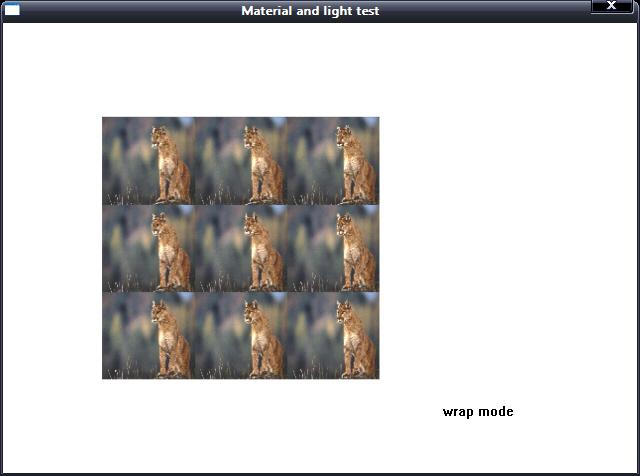
包裹模式
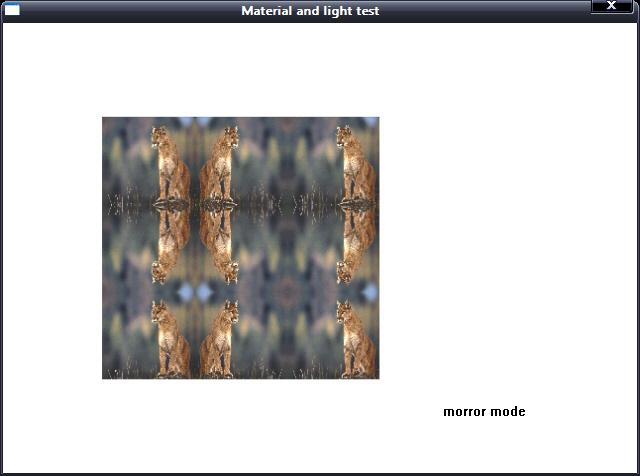
镜像模式
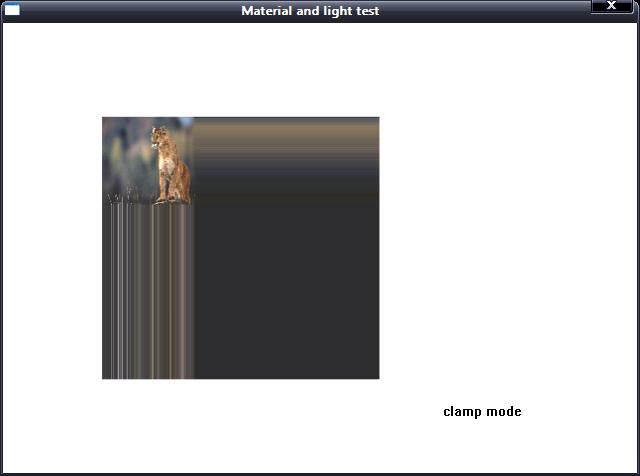
夹子模式
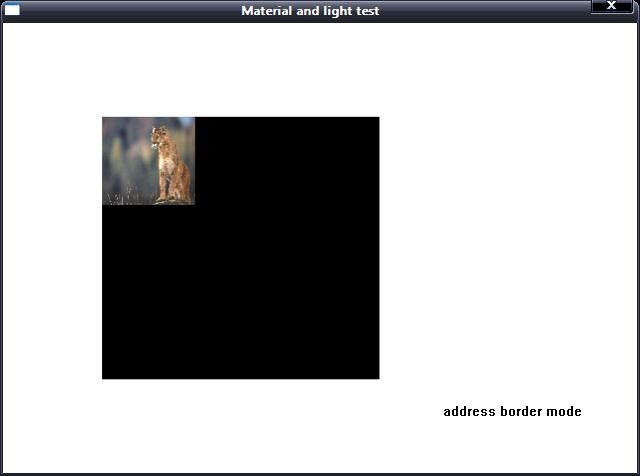
边界模式
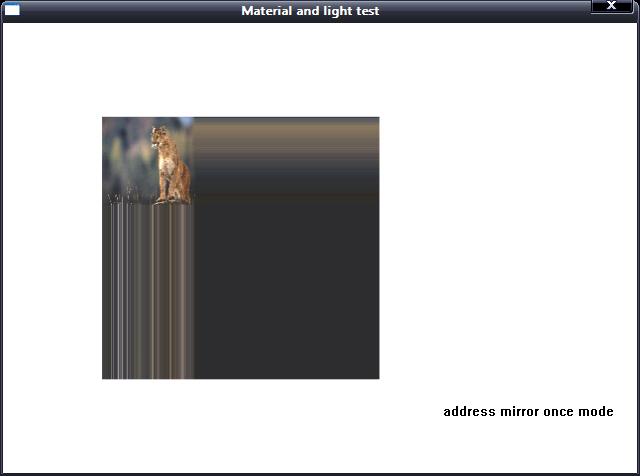
一次镜像模式